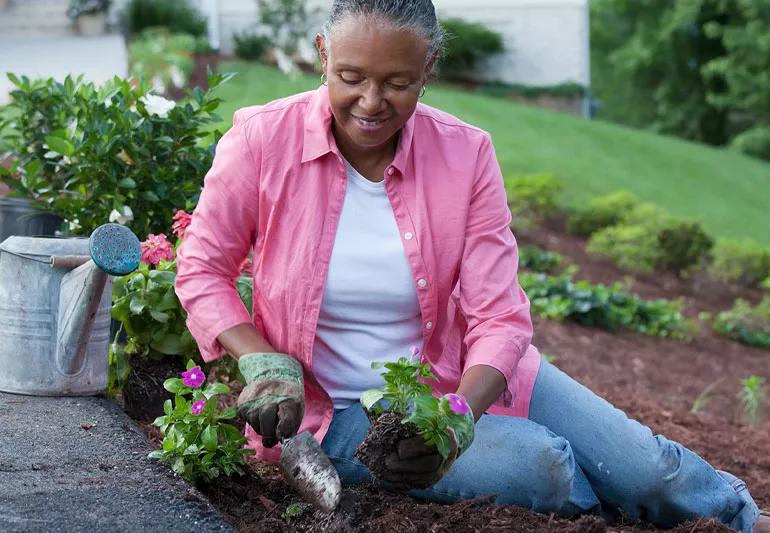Specialist Gardening Tips for Developing a Sustainable and Eco-Friendly Garden
Beginning on the journey to produce a eco-friendly and sustainable yard includes a collection of calculated options and practices that not just improve the appeal of your area but likewise add favorably to the setting. To reveal more skilled understandings and sensible methods, allow us explore the essential elements that specify an environmentally conscious yard.
Pick Native Plants
Picking indigenous plants for your garden is an essential action towards achieving sustainability. Furthermore, native plants typically require much less water when established, adding to more efficient water use.
Beyond their functional advantages, native plants play an important role in supporting regional biodiversity. They give essential environment and food resources for indigenous wild animals, consisting of pollinators such as bees, butterflies, and birds. This fosters a well balanced ecosystem, which is essential for the health and wellness of your yard and the surrounding atmosphere.

Implement Water Preservation
Implementing water conservation techniques is necessary for maintaining a lasting garden. Efficient water use not only decreases the environmental influence however additionally ensures that plants receive ample hydration without wastage. One efficient technique is to use drip watering systems, which supply water straight to the plant roots, lowering evaporation and runoff. This targeted strategy can considerably lower water usage compared to traditional sprinklers.
On top of that, mulching is an important practice for conserving water. By applying a layer of natural mulch, such as timber chips or straw, around the base of plants, garden enthusiasts can minimize dirt dissipation and keep regular wetness degrees. Compost likewise aids regulate soil temperature level and suppresses weed development, more adding to plant health and wellness.
Rainwater harvesting is an additional sustainable approach. Installing rain barrels or other collection systems allows gardeners to store and capture rainwater, which can later be used throughout dry periods. This not only saves metropolitan water however likewise provides an all-natural, chemical-free source for watering.
Finally, selecting drought-tolerant plant species can considerably minimize water demands. These plants are adapted to grow in low-water conditions, making them optimal for environment-friendly yards. gardening tips. Carrying out these water conservation approaches will promote a durable, lasting yard
Use Organic Gardening Methods

Pest administration in a natural yard relies on incorporated parasite monitoring (IPM) methods. These consist of motivating advantageous insects, making use of natural killers like ladybugs and lacewings, and carrying out plant rotation to interfere with pest life process. Companion planting, where particular plants are grown with each other to ward off bugs or attract valuable bugs, is one more reliable method.
Weed control is taken care of through mulching and manual elimination, instead of depending on herbicides. Mulch not only reduces weeds yet additionally conserves dampness and improves soil health as it damages down. Organic composts, such as straw, timber chips, and leaves, are especially advantageous.
Develop Wildlife Habitats
Producing wild animals habitats within your yard not only boosts biodiversity but also supports the community's equilibrium. By making spaces that bring in and maintain regional fauna, you can create a successful micro-ecosystem that profits both plants and animals. Beginning by integrating native plants, as these are well-suited to your local climate and provide necessary food and shelter for wild animals. Native vegetation supports a range of insects, birds, and tiny animals, adding to the environmental network.
Take into consideration including site link a water feature, such as a pond or birdbath, to give a constant water resource. Water components attract a selection of types, from amphibians to pollinators, enhancing the yard's vitality. Furthermore, setting up birdhouses, bat boxes, and insect resorts provides risk-free nesting websites and motivates biodiversity.
Leave some locations of your yard undisturbed, allowing fallen leave clutter and dropped branches to build up. These all-natural particles heaps develop habitats for bugs and little creatures, fostering a balanced community. Prevent using chemical pesticides and herbicides, as they can hurt valuable wildlife and interrupt food web. By prioritizing these sustainable methods, your garden can come to be a haven for neighborhood wild animals, advertising eco-friendly wellness and sustainability.
Technique Composting and Mulching
A vital facet of lasting horticulture, composting and mulching, considerably boosts dirt wellness and reduces waste. Unlike synthetic fertilizers, garden compost enriches the dirt with advantageous bacteria and vital nutrients, promoting a much healthier yard community.
Mulching, on the various other hand, includes covering the dirt surface area with inorganic or organic materials, such as straw, timber chips, or shredded leaves. This method uses numerous advantages: it preserves dirt moisture, reduces weed growth, and moderates dirt temperature. Mulch likewise slowly breaks down, including raw visit this website material to the soil and additional boosting its fertility.
To practice efficient composting, ensure your garden compost heap has a balance of eco-friendly materials (abundant in nitrogen) and brownish materials (abundant in carbon), keeping adequate aeration and moisture. gardening tips. Routinely turning the pile increases decomposition. For mulching, use a 2-3 inch layer around plants, guaranteeing it does not directly contact stems or trunks to stop rot
Conclusion

Selecting native plants for your garden is a fundamental action towards accomplishing sustainability.Furthermore, including native plants can enhance the visual appeal of your yard. These plants are adapted to prosper in low-water problems, making them suitable for environment-friendly yards. Applying these water preservation approaches will promote a resistant, sustainable yard.
In verdict, establishing a sustainable and environmentally friendly garden involves the tactical selection of native plants, the fostering of water conservation strategies, and the implementation of natural gardening check my source methods.